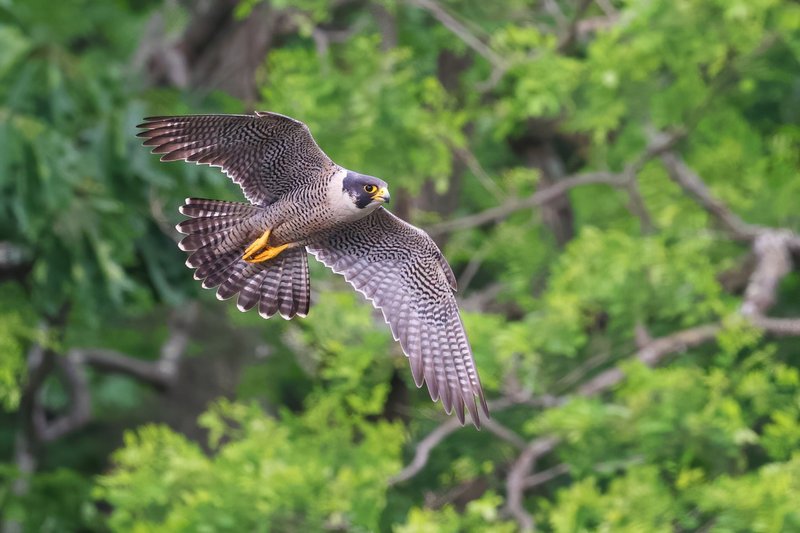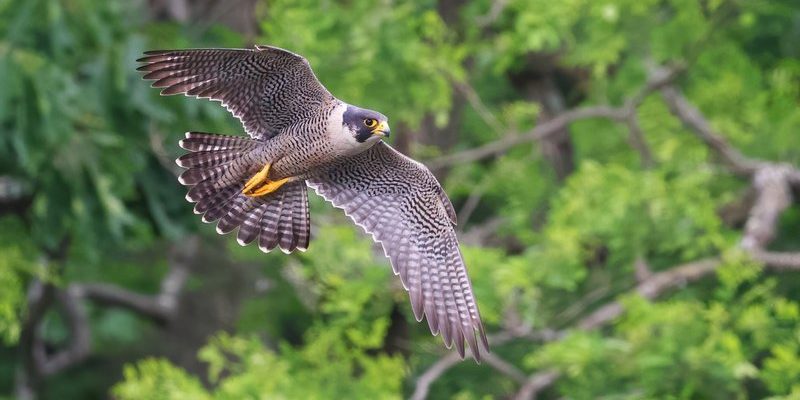
So, let’s dive into the world of these remarkable raptors and explore their conservation status. We’ll look at their incredible traits, the threats they face, and what’s being done globally to protect them. It’s a bit of a rollercoaster ride through biology, environmental science, and conservation efforts. Grab your coffee; it’s time to learn!
Understanding the Peregrine Falcon
The peregrine falcon, or Falco peregrinus, is a bird of prey known for its striking blue-gray plumage and distinctive black helmet-like cap. They are found on every continent except Antarctica. Picture them perched high on skyscrapers or cliff edges, keeping a watchful eye for their next meal. These birds primarily hunt medium-sized birds, using their exceptional speed and agility to catch them mid-flight.
One fascinating aspect of the peregrine falcon is its breeding behavior. They are monogamous and often mate for life. During courtship, males perform aerial displays to impress their potential partners. It’s a spectacular sight that many bird enthusiasts cherish. Their nesting sites are usually on high ledges, providing a safe place for their young to grow before they take their first flights.
However, these remarkable birds are not just fascinating to watch—they play a crucial role in their ecosystems. As apex predators, peregrine falcons help maintain the balance of populations of birds and pests. Their presence indicates a healthy environment, just like the canary in the coal mine!
Current Conservation Status
As of now, the peregrine falcon is classified as “Least Concern” by the International Union for Conservation of Nature (IUCN). This classification means they are not currently facing the risk of extinction. However, their journey to recovery has been anything but straightforward. In the mid-20th century, they faced drastic declines due to pesticide use, particularly DDT, which caused eggshell thinning.
Thanks to concerted conservation efforts, including banning harmful pesticides and establishing recovery programs, peregrine falcons have made a significant comeback in many areas. Their populations have stabilized and even thrived, especially in urban settings where they nest on tall buildings and bridges. It’s a classic case of nature adapting to human-made environments.
Yet, while the outlook is positive in some regions, it’s crucial to monitor their populations continuously. Changes in habitat and climate can quickly reverse gains. Here’s the thing: conservation is an ongoing effort.
Main Threats to Peregrine Falcons
While peregrine falcons have bounced back, they still face multiple threats that can jeopardize their stability. Here’s a closer look at some of these challenges:
- Pollution: Chemicals like pesticides can harm peregrine falcons directly or reduce their prey availability. These substances can accumulate in the food chain, affecting entire ecosystems.
- Habitat Loss: Urban development can lead to the destruction of natural habitats where these birds might nest or hunt. Although they adapt to urban environments, not all habitats can support them.
- Climate Change: Shifts in climate can affect migratory patterns and food availability. Changes in weather can also impact nesting success, leading to fewer fledglings surviving.
- Human Disturbance: Nesting sites can be disturbed by human activities, including construction and excessive recreational activities near their habitats.
It’s a tough world for these birds, and they must navigate various dangers just to thrive.
Global Conservation Efforts
Conservationists have rallied around the peregrine falcon, leading various initiatives aimed at protecting this incredible species. These efforts vary by region but share a common goal: to ensure the long-term survival of the peregrine falcon. Let’s highlight some notable programs:
- Breeding Programs: Many conservation organizations engage in breeding and release programs to help boost falcon populations in the wild. These efforts often involve raising chicks in captivity and then releasing them into safe habitats.
- Public Awareness Campaigns: Educating the public about the importance of peregrine falcons is crucial. When people understand why these birds matter, they’re more likely to take action to protect their habitats.
- Legal Protections: Various laws, such as the Migratory Bird Treaty Act, help shield peregrine falcons from hunting and habitat destruction. Governments and NGOs work together to enforce these protections.
- Monitoring Programs: Research is key to understanding population dynamics and health. Many organizations use telemetry and banding to track individual birds, providing insights into their survival and behaviors.
Thanks to these collective efforts, peregrine falcons have regained a foothold in many areas, showcasing the power of concerted conservation action.
The Role of Technology in Conservation
Technology plays a vital role in modern conservation efforts, including those aimed at protecting peregrine falcons. Here are some ways technology is making a difference:
- Tracking Devices: Many conservationists use GPS tracking to monitor peregrine falcons. This data helps scientists understand their migratory patterns and home ranges, informing conservation strategies.
- Camera Systems: Nesting sites are often equipped with live cameras, allowing both researchers and the public to observe falcon behavior. These cameras can also help protect nests from human interference.
- Data Analysis Tools: Advanced software allows researchers to analyze large sets of data quickly. This analysis helps in understanding threats and population trends more effectively.
- Citizen Science: Apps and platforms encourage the public to report sightings and nest locations. This engagement helps build a robust database for tracking peregrine falcon populations.
By leveraging these technological advancements, conservationists can take precise actions to protect and support peregrine falcon populations.
What Can You Do to Help?
If you’re feeling inspired and want to contribute to the conservation of peregrine falcons, there are several actions you can take:
- Support Conservation Organizations: Donate or volunteer with groups that focus on bird conservation. Your time or financial support can make a significant impact.
- Educate Others: Share what you learn about peregrine falcons with friends and family. The more people know, the more likely they are to protect these amazing birds.
- Be Mindful of Habitat: When enjoying the outdoors, respect bird habitats. Stay on trails and minimize noise around known nesting areas.
- Advocate for Policies: Support local and national policies that protect wildlife and their habitats. Engaging in conversations about conservation can lead to positive changes.
Every small action counts. By working together, we can help ensure that future generations will marvel at the beauty and speed of the peregrine falcon.
So, is the peregrine falcon endangered? As of now, they aren’t classified as endangered, thanks to extensive conservation efforts that have led to their recovery in many areas. However, it’s essential to remain vigilant about the ongoing threats they face. The journey of the peregrine falcon teaches us about resilience and the importance of taking action to protect our natural world.
By supporting conservation initiatives and spreading awareness, we can make a difference. When we take the time to appreciate these exceptional birds, we not only celebrate their beauty but also commit to safeguarding their future. Together, let’s ensure that the skies continue to echo with the calls of the peregrine falcon for generations to come.

